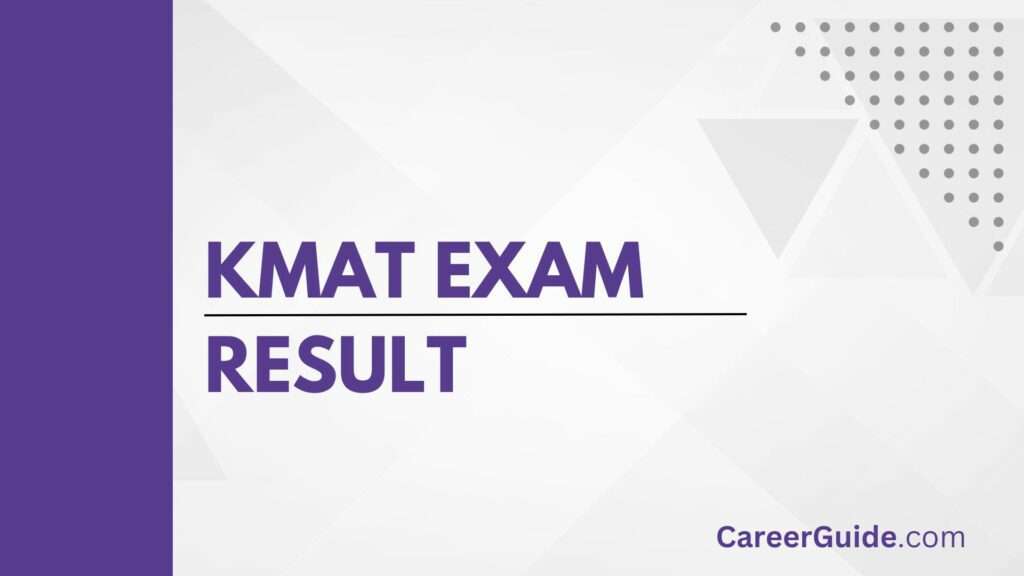KMAT Exam Result: The Karnataka Management Aptitude Test (KMAT) is a state-level management entrance examination conducted by the Karnataka Private Post Graduate Colleges Association (KPPGCA). KMAT is a gateway for admission to MBA, PGDM, and MCA programs offered by various B-schools and universities in the state of Karnataka.
To succeed in KMAT, it’s crucial to have a comprehensive understanding of the exam syllabus. In this extensive guide, we will explore the KMAT syllabus in detail, covering various aspects of each section, key topics, and preparation strategies.

Understanding the KMAT Scoring System:
Before delving into the details of KMAT exam results, it’s crucial to understand how the exam is scored. KMAT follows a scoring pattern where each section of the test is assigned a certain number of marks. The total marks for the exam are generally 120, with each correct answer carrying one mark, and there is no negative marking for incorrect answers.
KMAT typically consists of three sections:
Verbal Ability and Reading Comprehension (VARC): This section assesses a candidate’s English language proficiency, vocabulary, and reading comprehension skills. It usually comprises 40 questions, each worth one mark.
Quantitative Ability (QA): The QA section evaluates a candidate’s mathematical and quantitative reasoning abilities. Like VARC, it consists of 40 questions, each carrying one mark.
Logical Reasoning (LR): The LR section tests a candidate’s logical and analytical reasoning skills. It also comprises 40 questions, with each question worth one mark.
The total marks for KMAT are calculated by adding the marks obtained in each section. Candidates are not penalized for wrong answers, so they should attempt all questions to maximize their score.
Announcement of KMAT Results
This announcement of KMAT exam results is a highly anticipated event for candidates aspiring to pursue management studies in Karnataka. The Karnataka Private Post Graduate Colleges Association (KPPGCA), which conducts the KMAT exam, usually follows a specific timeline for result declaration. Here’s how the process typically unfolds:
1. Publication of Provisional Answer Key:
- Before the official results are declared, KPPGCA often releases a provisional answer key for KMAT. This provisional key contains the correct answers to the questions asked in the exam.
- Candidates are given a window of time during which they can raise objections or challenges to the provisional answer key if they believe there are discrepancies.
2. Evaluation and Finalization:
- After considering any challenges or objections raised by candidates, KPPGCA finalizes the answer key.
- The final answer key is used as the basis for evaluating the candidates’ responses in the exam.
3. Result Declaration:
- Once the evaluation process is complete, KPPGCA officially announces the KMAT exam results.
- The results are typically published on the official KMAT website (kmatindia.com) and are made accessible to candidates through their login credentials.
4. Scorecard Download:
- Along with the result announcement, KPPGCA provides candidates with the option to download their KMAT scorecards.
- The scorecard contains essential information, including the candidate’s name, roll number, sectional scores, and overall percentile.
How to Check KMAT Results
Checking your KMAT exam results is a straightforward process. Here are the steps to follow:
Step 1: Visit the Official KMAT Website
- Open your web browser and visit the official KMAT website, which is typically kmatindia.com.
Step 2: Navigate to the Result Portal
- Look for a section or link on the website that is specifically dedicated to KMAT results. This section is often labeled “Results” or “Scorecard.”
Step 3: Log in to Your Account
- To access your results, you will need to log in to your KMAT account. This will require entering your credentials, such as your application number and password.
Step 4: Download Your Scorecard
- Once you have successfully logged in, you should be able to view and download your KMAT scorecard.
- Make sure to save a copy of your scorecard for future reference.
Important Information on the KMAT Scorecard
Your KMAT scorecard contains several key pieces of information that are crucial for the admission process. Here’s what you can typically find on your KMAT scorecard:
Candidate’s Name: Your full name as provided during the registration process.
Roll Number/Registration Number: A unique identification number assigned to you for the KMAT examination.
Date of Birth: Your date of birth as mentioned in your application.
Photograph: A passport-sized photograph of the candidate.
Sectional Scores: The marks obtained in each of the three sections of the KMAT exam—Verbal Ability and Reading Comprehension (VARC), Quantitative Ability (QA), and Logical Reasoning (LR).
Overall Percentile: This percentile indicates your performance relative to other test takers. It reflects the percentage of candidates who scored lower than you in the KMAT exam.
Category: Your category or reservation category, if applicable (e.g., General, SC, ST, OBC, EWS).
Interpreting Your KMAT Scores
Understanding your KMAT scores is essential for gauging your performance and making informed decisions regarding your MBA, PGDM, or MCA admission. Here’s how to interpret your scores:
Sectional Scores: Examine your scores in each of the three sections—VARC, QA, and LR. These scores indicate your performance in specific skill areas. You can identify your strengths and weaknesses based on these scores.
Overall Percentile: Your overall percentile is a crucial metric. It tells you where you stand relative to other test takers. For example, if your overall percentile is 90, it means you performed better than 90% of the candidates who took the KMAT exam.
Category Percentile (if applicable): If you belong to a reserved category (e.g., SC, ST, OBC, EWS), your category percentile will show how you performed compared to candidates within your category.
Comparison with Cutoffs: To assess your chances of admission to specific management institutions, you should compare your scores with the cutoff scores specified by those institutions. Cutoff scores vary from one institution to another and may change from year to year.
Using KMAT Scores for Admission
Once you have received your KMAT scores, the next step is to utilize them for the admission process. Here’s how to go about it:
1. Research Participating Institutions:
- Start by identifying the management institutions in Karnataka that accept KMAT scores for admission.
- Research each institution’s admission criteria, including the cutoff scores, application deadlines, and any additional requirements.
2. Check Cutoff Scores:
- Determine whether your KMAT scores meet or exceed the cutoff scores specified by the institutions you are interested in.
- Keep in mind that different institutions may have varying cutoffs, and some may prioritize different sections of the KMAT exam.
3. Apply to Preferred Institutions:
- Complete the application process for the management institutions you wish to apply to. This typically involves submitting an online application form along with your KMAT scores.
4. Attend Group Discussions and Interviews (if required):
- Some institutions may require candidates to participate in group discussions (GD) and personal interviews (PI) as part of their selection process.
- Prepare for GD and PI rounds if you are shortlisted.
5. Wait for Admission Offers:
- After applying, wait for admission offers from the institutions you have applied to. Offers may be communicated via email, the institution’s website, or through physical mail.
6. Choose Your Preferred Institution:
- Once you receive admission offers, carefully consider your options and select the institution that aligns best with your career goals, preferences, and financial considerations.
7. Pay Admission Fees and Complete Enrollment:
- After selecting an institution, follow the admission guidelines provided by that institution. This may involve paying admission fees, submitting required documents, and completing the enrollment process.
8. Prepare for the Academic Year:
- Once you have secured admission, prepare for the start of the academic year. This may include orientation sessions, course registration, and other administrative tasks.
Revaluation and Rechecking
If a candidate believes that there has been an error in the evaluation of their KMAT exam paper, they may have the option to request revaluation or rechecking. However, it’s essential to note that the process and policies for revaluation can vary from one year to another and may not be available in all instances.
Candidates who wish to pursue revaluation or rechecking of their KMAT exam paper should closely follow the official announcements and guidelines provided by KPPGCA. This process typically involves submitting a formal request and paying a revaluation fee. The decision following revaluation is considered final.
Important Considerations for KMAT Exam Results
Here are some key points to keep in mind regarding KMAT exam results:
Score Validity: KMAT scores are generally valid for one academic year. This means that you can use your KMAT scores for admission in the academic year in which the exam was taken. However, candidates should confirm the score’s validity with the participating institutions they plan to apply to, as policies may change.
Multiple Attempts: Candidates are allowed to take the KMAT exam multiple times. If you are not satisfied with your scores in one attempt, you can try again in subsequent years to improve your performance.
Institution-specific Requirements: Each participating institution may have specific admission requirements and criteria beyond KMAT scores. These could include work experience, entrance test scores from other exams, and academic qualifications.
Reservation Policies: Candidates belonging to specific categories, such as Scheduled Castes (SC), Scheduled Tribes (ST), Other Backward Classes (OBC), Economically Weaker Sections (EWS), and others, should review the reservation policies of the participating institutions they intend to apply to. Institutions may have varying percentages of seats reserved for different categories.
Career Counseling: If you have doubts about which institutions to apply to or need guidance on choosing the right management program, consider seeking career counseling services. Many educational institutions and career counselors can provide valuable insights and assistance in making informed decisions.
FAQs
A: There are three sections in the KMAT exam:
- Quantitative Aptitude
- Verbal Ability
- Logical Reasoning
A: There are 60 questions in each section of the KMAT exam.
A: total duration of the KMAT exam is 3 hours.
A: Each question in the KMAT exam carries 4 marks. There is no negative marking for incorrect answers.
A: this is no sectional cut-off in the KMAT exam. However, candidates must score a minimum of 30% in each section to be eligible for the final merit list.










